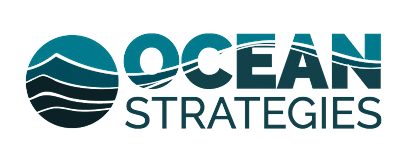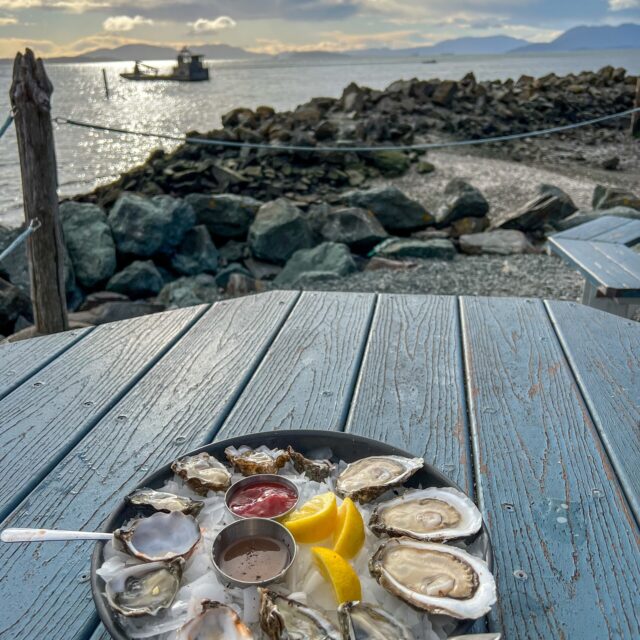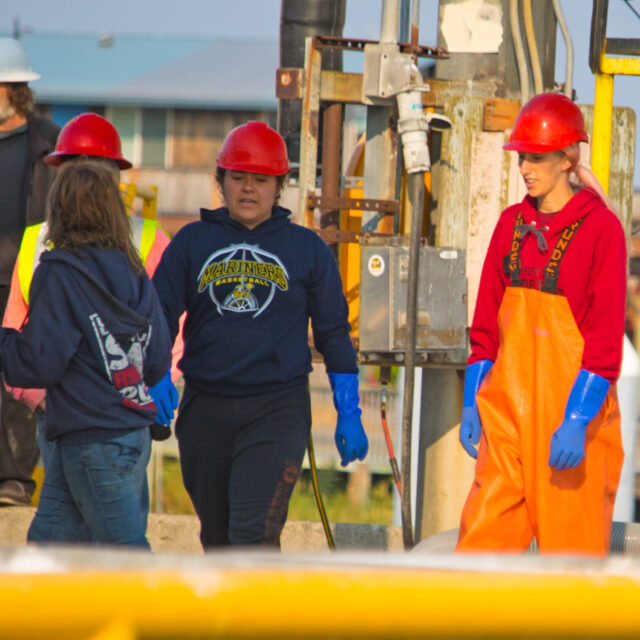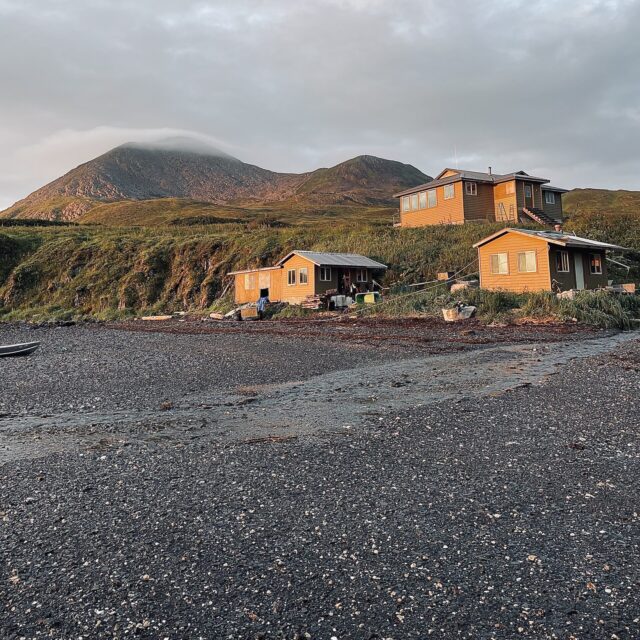
Ocean Strategies is a public affairs firm specializing in seafood, fisheries and marine resources.
This report provides policy and industry updates for those who rely on access to sustainable U.S. seafood. Sign up here.
Included In The Report
- Seafood processing: Tight global economics reveal the cracks in a pillar of our domestic industry
- Federal Policy Updates
- Reports & Publications
- News Thread
- Staff Picks: What We’re Reading, Watching & Listening to
- Events & Opportunities
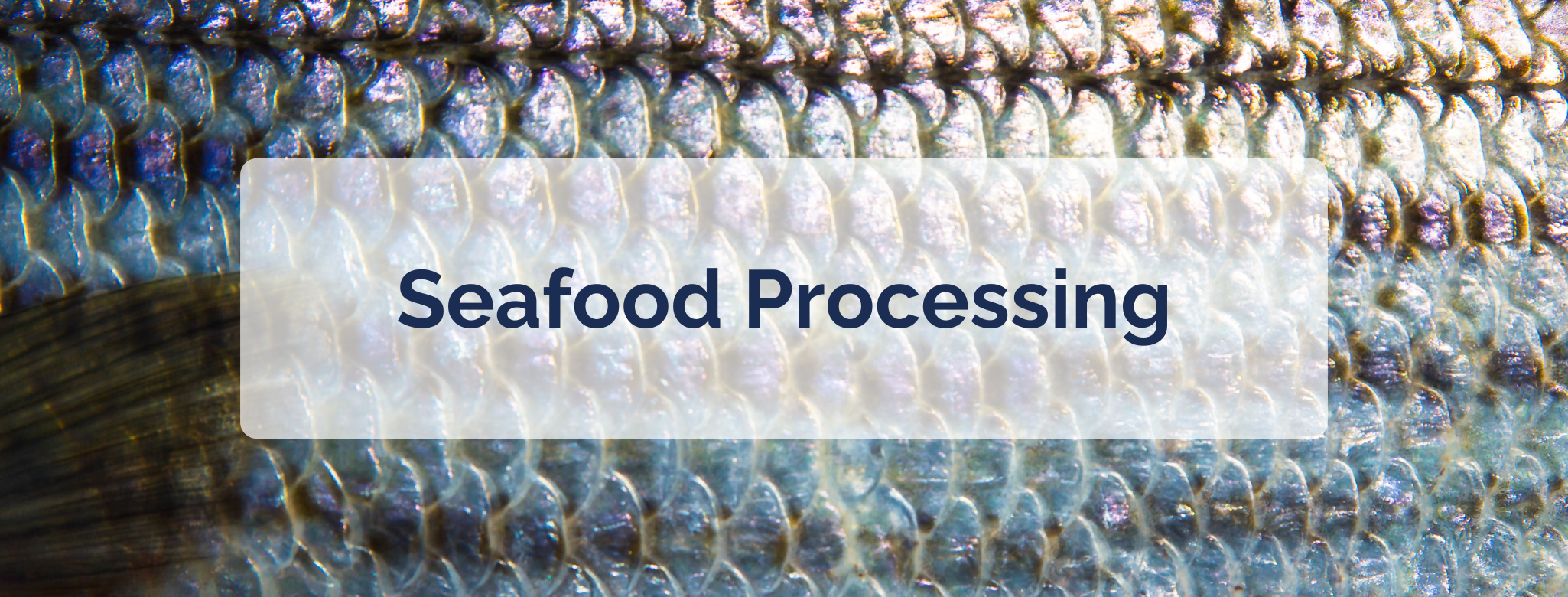
Seafood processing: Tight global economics reveal the cracks in a pillar of our domestic industry
Alaska’s processing sector woes have only gotten worse since our 2024 Outlook published in December. The stressors are now affecting most of the major processors. Hundreds of Alaskan businesses and families are still reeling as the industry continues to manage the fallout of shutdowns.
The trend started with Trident Seafoods’ December announcement that they would be selling processing facilities in Kodiak, False Pass, Petersberg, and Ketchikan — more than a third of their Alaskan processing facilities. Trident Seafoods is currently the nation’s largest seafood company. But this was followed by Peter Pan Seafoods’ shutting down its King Cove facility during pollock A-season and then the loss of its Sand Point plant to fire. And more recently an announcement from OBI to shutter its Larsen Bay plant for the summer salmon season.
There’s little chance we’ve seen the last of it. But we also now have an opportunity to change the way Alaska’s seafood industry is structured to reduce dependence on single operators and increase flexibility.
What makes Alaska different?
Many of Alaska’s fishing ports are remote in a way most of us in the Lower 48 can’t understand or relate to. If you’re on the coast but not on the road system in Alaska (which is the case with most ports), then you may well rely on your local processor (bonus if you have more than one to choose from) to supply critical infrastructure like fuel, ice, and even electricity.
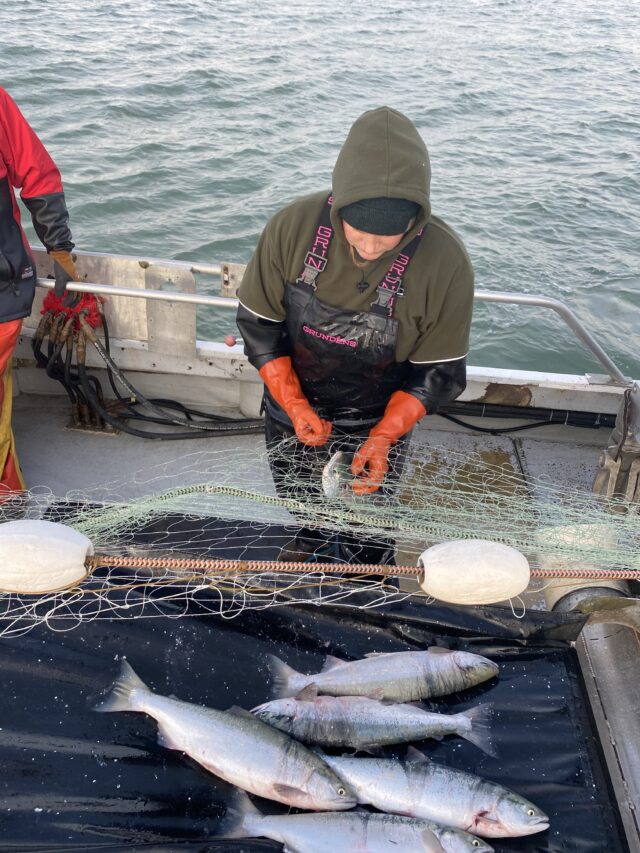
The scale of Alaska’s seafood bounty combined with its geography, remoteness, and rugged terrain means that most of its catch is funneled through two channels:
- Subsistence/recreational/personal use: Processed at home or via boutique operations that smoke, can and/or freeze for home storage; or
- Commercial landings: Processed at a large shoreside facility, at sea, or shipped frozen to be processed overseas for the purpose of exporting to the Lower 48 and across the globe.
If you travel to a fishing town in Alaska, you may be excited about heading to the local fishmonger to pick up a fresh catch or dine in a local seafood restaurant. In many fishing towns, the best way to eat local seafood is to know a local with a freezer, an opener or a direct-marketing operation.
While this may be normal in Alaska, what it means is that locals have few options to access their own local bounty without the right connections. If the local fishery doesn’t open for whatever reason, there may be no local retailer who can bring in product from other regions — either because seafood isn’t a typical product for them or because it’s too difficult (and expensive) to bring in fresh or even frozen seafood.
Who does that leave out of the loop? Oftentimes, it’s the people who can’t hunt or fish on their own — the elderly, disabled, parents with young children.
Shared risk
What’s NOT different about Alaska are the risks (and realities) of consolidation and loss of access to processing and what that means for fishing communities nationwide.
The Alitak region of fishermen comprises more than 30 setnet sites and 5-10 seiners who have delivered to a local tender and processor for more than 100 years. For many of those years, it was typical to have more than one buyer send tenders to the area, eager to buy fish from the local fleet. They’ve been down to one buyer for several years now, the one that owns the only shoreside facility in the area.
The Larsen Bay shoreside facility historically has provided critical local infrastructure, like access to fuel, propane and other basic supplies. For the fishery, it also provides storage, ice, mechanical support and of course a buyer. That processor, now OBI (owned by Cooke), announced in early March that they would not be supporting the setnet fishery as a buyer, nor would they be able to store the fleet’s gear or provide ice or fuel for the season.
(Read more about this from Ocean Strategies’ Hannah Heimbuch, who is one of those setnet site owners now at risk of losing a season or more without a local buyer.)
This dependence on local processing — as well as the inherent risks to the processing sector that result from decades of consolidation — is not unique to Alaska. And the loss for any community can be devastating.
As processors work to make their disparate and often far-flung operations pencil out following a tough year for the global seafood marketplace, the biggest losses go to some of the most vulnerable operations and locations.
The more remote a fishery or port is, the more expensive it is to provide services. That means the most remote fisheries and ports are likely to get cut off first, and they’re also the locations least likely to find a new processor or buyer in short order.
New processing concepts
Enter: The next generation for inspiration.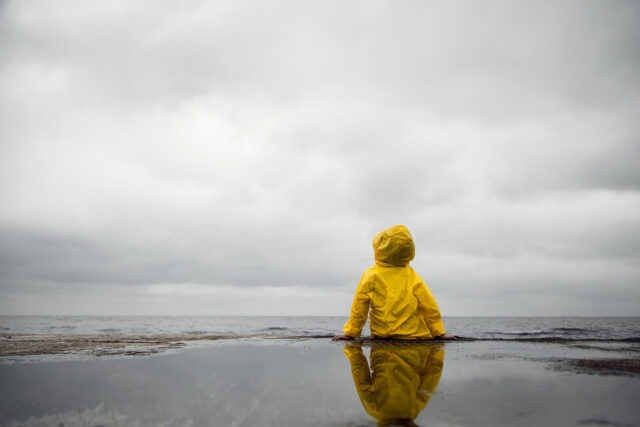
Community-based cooperatives, membership models and direct marketing efforts are well established and growing, especially in the wake of the covid-era strain on the traditional supply chain and outlets.
The community-supported fishery Alaskans Own — a project of the Alaska Longline Fishermen’s Association — has been running for 10 years. The CSF was established in part to channel more local fish to local communities in Alaska (see above).
Although processing barges are not a new concept, the model is evolving. This year, two relatively young processing companies are launching barges to support salmon fisheries in Alaska.
Northline Seafoods’ barge Hannah has launched from the Port of Bellingham, Wash., and is on its way to Bristol Bay. Circle Seafoods, meanwhile, is set to operate a new barge in Southeast Alaska.

Federal Outlook
Congress voted in March to avoid another shutdown, as industry stakeholders keep tabs on bills and agency budgets.
A suite of legislative proposals came at the end of last year, which we’re continuing to track, in addition to the forthcoming proposed rule from NOAA Fisheries on potential changes to three of the Magnuson-Stevens Act’s 10 National Standards which outline agency priorities and interpretations of the act, providing instructions for the regional councils to use when creating and amending fishery management plans.
The agency invited public comment on proposals to update standards 4 (Allocations), 8 (Bycatch) and 9 (Community), and is expected to incorporate that feedback into its forthcoming proposal.
Hear more about it from NOAA Fisheries Administrator Janet Coit — as well as the agency’s input on the Russian seafood ban, the National Seafood Strategy and our Fisheries Economic Ecosystem.
On the Hill, federal fisheries bills proliferated around legislation that may or may not move forward this year, including a possible Magnuson reintroduction.
A pair of working waterfront preservation bills has transformed into a trio that aims to maintain access to the waterfronts in coastal communities for our nation’s fishermen and other maritime workers, supporting commercial fishing, aquaculture, boatbuilding, and other vital community shoreside activities.
The Working Waterfronts Act, introduced by Sens. Lisa Murkwoski (R-Alaska) and Susan Collins (R-Maine), includes the FISH Wellness Act (description below) and would incentivize:
- Commercial fishing boats transitioning to alternative fuels, including hybrid power
- Maritime workforce development
- Ocean Cluster investment
- Working waterfront infrastructure grants
- Habitat research and monitoring
The Working Waterfronts Preservation Act (introduced by Maine Sen. Susan Collins and Rhode Island Sen. Jack Reed):
- Would establish a $20 million grant program to help municipal and state governments, nonprofit organizations, and participants in maritime industries purchase or improve working waterfront property in coastal states.
- Grants would be administered by the Economic Development Administration, and successful applicants would need to be endorsed by state fisheries agencies.
- Eligible recipients would be required to permanently protect an area as working waterfront.
Keep America’s Waterfronts Working Act (introduced by Maine Rep. Chellie Pingree and Virginia Rep. Rob Wittman):
- Establishes a Working Waterfronts Grant Program to provide matching, competitive grants to coastal states, Tribes, and Native Hawaiian Organizations to help preserve and expand access to coastal waters for water-dependent businesses.
- Creates a loan fund for working waterfronts preservation, modeled after state drinking water loans.
- Authorizes $50 million each for both the loan and grant programs.
- Organizes a Working Waterfronts Task Force at the Department of Commerce to identify and prioritize critical needs for working waterfronts, especially in the face of the climate crisis and increased trade threats.
The Fishing Industry Safety Health and Wellness (FISH Wellness) Act, introduced by Senators Ed Markey (D-Mass.), Dan Sullivan (R-Alaska), Susan Collins (R-Maine), Jeff Merkley (D-Ore.), Lisa Murkowski (R-Alaska), Jeanne Shaheen (D-New Hampshire), and Roger Wicker (R-Miss.), proposes to put commercial fishing safety training on an even fiscal playing field with other programs of its type across industries served by the National Institutes for Occupational Safety and Health.
Conference Round-Up
Fishing is seasonal work for many, but seafood is a 24/7 topic. Mid-fall and spring are meeting-season hotspots for Team Ocean Strategies, culminating this year in a coast-to-coast route that spanned from market expos to international fisheries science talks. It showcased the myriad work that makes seafood a pillar of coastal community life, a global commodity, and a nutrition cornerstone connecting billions of people to the ocean.
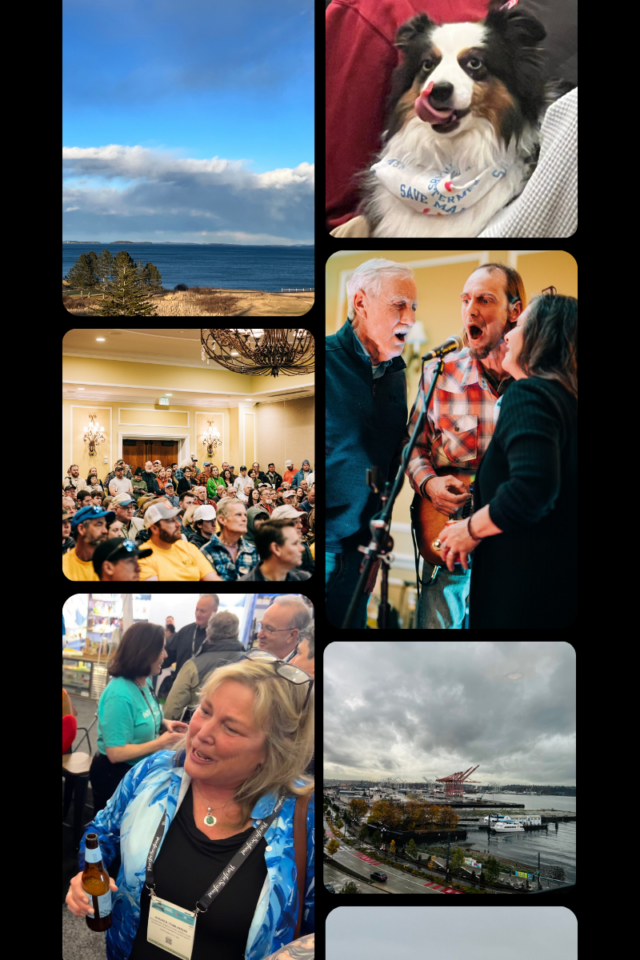 Rockport, Maine — Maine Fishermen’s Forum
Rockport, Maine — Maine Fishermen’s Forum
The Maine Fishermen’s Forum, an annual event at which lobstermen are the majority by a long shot, was surprisingly upbeat this year. Despite the many long, uphill battles Maine’s fishermen are facing — wind, whales and working waterfront infrastructure woes — most of the state’s fleet had enough to keep their boats and homes running. And many of them also committed to volunteering their time to more than one community-based cause.
Although it’s a Maine-focused event packed with industry-curated conference sessions and social events, the forum is truly an opportunity to connect with people from every corner of the industry in a casual and cozy setting. Anyone who works, as we do, on the preservation and resilience of community-based fisheries and aquaculture would have much to share and learn in this environment. (Where else are you going to see a senator sing with a band named Turd Pollock?) We hope to see more of you there next year to celebrate 50 years of the forum!
Seattle — World Fisheries Congress
Next up was a visit to the World Fisheries Congress, an international scientific gathering that occurs just once every four years. While we often find ourselves amid the people that manage, catch and sell seafood, this convening focuses on the expansive scientific work that underpins oceanic and freshwater fisheries. Familiar colleagues from around the U.S. joined more than a thousand others from 70+ countries, sharing short talks on their recent research. It’s an opportunity for the planet’s fisheries experts to exchange ideas, much of it focused on the ecological and social sustainability of water systems as providers of food, economy, and culture. 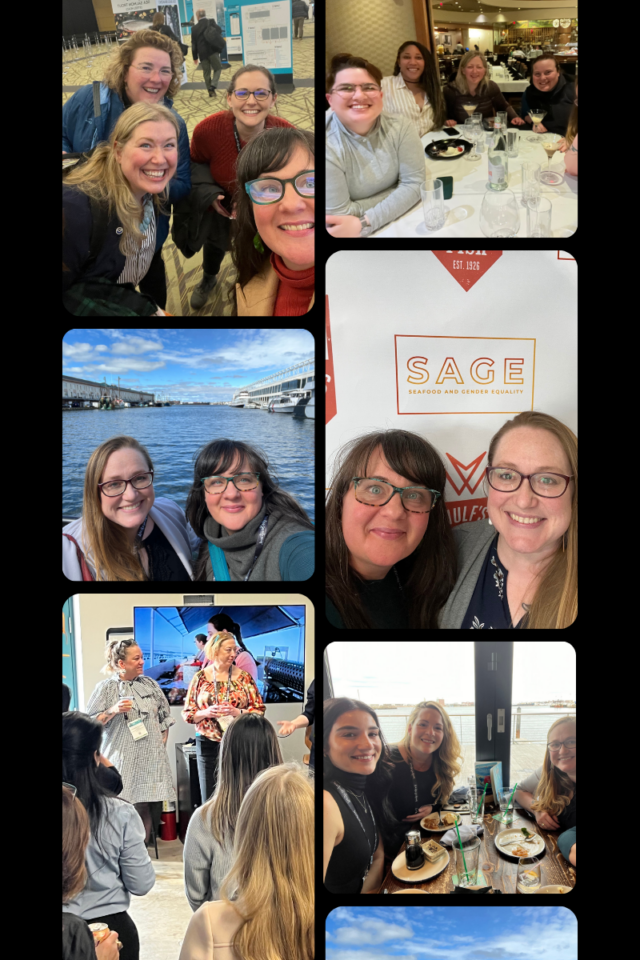
A favorite conversation during this event was on environmental DNA research and its potential to complement, and someday fundamentally shift, our approach to stock and ecosystem assessments in fisheries management. Examining the eDNA in water samples allows a researcher to assess the biodiversity present at the sample location, and estimate biomass of key species in the area, at that time. Technological advances, coupled with research increasing the understanding of eDNA dynamics in oceanic and freshwater ecosystems, are making it increasingly possible to move the field from targeted research, to survey tool.
Fisheries science spans a wide array of focus areas, including biology, limnology, oceanography, chemistry, economics, anthropology, and population dynamics – to name just a few. The 2024 Congress showcased the complexity of the field, and how it’s shifting in a world increasingly affected by climactic, ecological, technological and social change. As people often focused on industry debate and regulatory process, it was both refreshing and hopeful to peek through this window of scientific innovation. Through it we recognized that ever-present, universal human connection to the ocean, and a groundswell of people across the planet constantly working in thousands of ways to make it sustainable.
Boston — Seafood Expo North America
What can we say about Boston? It’s drinking from the firehose in the best possible way. Our four days in town — from 7 am to midnight daily — were spent jetting between conference sessions as well as meetings, shared meals and receptions with colleagues and friends. Oh and did we mention there’s a trade show, too? Just shy of 250,000 square feet (more than five and a half acres) of exhibit space. It’s typical to put in 20,000 steps in a day at SENA.
One thing we realized after we left the show this year was how much time we spent with women and other minority representatives of the industry. Without effort on our part, we found ourselves coalescing around events that celebrated leaders of innovation, and many (if not most) of those were not the standard men in suits that have long dominated the board rooms and decision-making of the domestic seafood industry.
This is not to say that men aren’t still overwhelmingly the majority voice or that elevating minority voices has been easy. But we are grateful for groups like Seafood and Gender Equality, the New England Young Fishermen’s Alliance, the ACME Smoked Fish Foundation’s Seafood Industry Climate Awards and the conference organizers at SENA for recognizing the now and future leaders who work tirelessly year-round to break new ground, open doors for new leadership, and pave the way for new markets for our domestic industry.
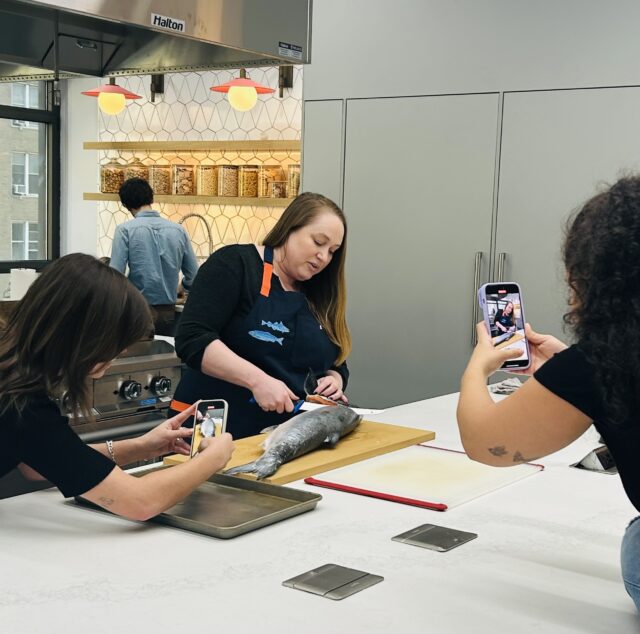 New York — Marketing Alaska Seafood
New York — Marketing Alaska Seafood
Last stop on this road show was a trip to New York to highlight the North Pacific’s wild fishes. Hannah joined the Alaska Seafood Marketing Institute for a series of filet demos and conversations, largely focused on sustainable salmon, how to break it down, and how to use all of it.
She visited with cookbook author and TV host Ali Rosen in her Manhattan studio kitchen, talking through the steps to filet a king salmon, where to find seafood in the store, and how to make it an easy and healthy part of family meals.
Next visit was the Delish test kitchen for another filet demonstration. Delish is one of the world’s leading digital resources for recipes and all things food, and this particular demo is destined for their Tiktok audience. These collaborations remind us, every time, how important it is for fishermen to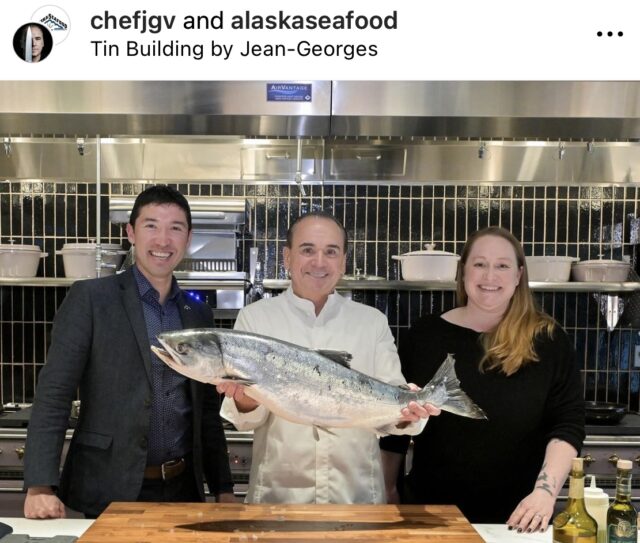 be ambassadors for the food that they harvest, share their stories, and invite people into a more personal understanding of the seafood they eat.
be ambassadors for the food that they harvest, share their stories, and invite people into a more personal understanding of the seafood they eat.
The trip closed out with a tasting event for myriad food writers and TV hosts held at the not-to-be-missed Tin Building, a unique market and food hall owned by world-renowned Chef Jean-Georges. The more than 100-year-old waterfront building was the original home of the Fulton Fish Market, at one time one of the largest wholesale seafood markets on the planet. While our New York stop was a quick whirlwind of modern storytelling platforms, our final event in this historic marketplace reminded us that seafood has been bringing people to market, and to the table, for ages.
Photo credit: Dave Waddell of Siousca Photography
Equity in Fisheries Distribution
National Academy of Sciences Report Offers Ways for NOAA to Improve Fisheries Equity
The public got its first look at a completed U.S. fisheries equity report earlier this spring, put out by a committee of experts through the National Academy of Sciences.
NOAA Fisheries requested the report to complement the agency’s Equity and Environmental Justice Strategy, released in 2023.
The NAS report details a series of discreet findings and recommendations, with an emphasis on ways to define, assess and integrate equity dimensions within the agency’s work. Particularly and immediately relevant, the authors describe the relevance of the National Standards within America’s federal fisheries laws as being fundamentally relevant to equity outcomes. The agency is currently considering a revision to agency guidelines for several of those National Standards, including those affecting the distribution of resources.
Author recommendations in this report include that the agency should: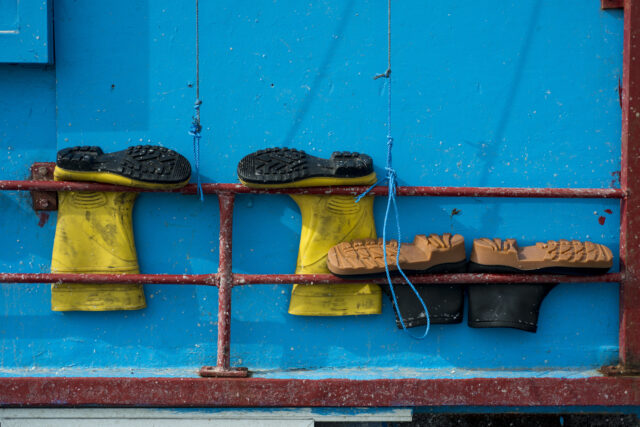
- Develop its internal social science capacity;
- Establish robust technical guidance for holistic equity approaches within their decision making structures; and
- Initiate data collection and sharing that further illustrates distributional outcomes.
These themes suggest that leading the challenges of achieving equitable resource management include:
- A lack of staff expertise in these complex social issues;
- Insufficient definitions and guidance for what constitutes equity and its contextual application to fishing communities; and
- A lack of statistical information from and about peoples that historically or presently experience inequity as a result of fisheries systems.
We highly recommend reading the 11-page summary at the top of the report for a helpful introduction into these issues, the dimensions and contexts of equity in terms of resource management, and the distinct ways that the agency could address them. The full report is focused on the distributional dimension of equity in U.S. fisheries, and includes:
- Federal equity mandates and relevance to fisheries management;
- Methods of fisheries access distribution and associated data systems;
- Beneficiaries of distribution and related impact findings; and
- Detailed recommendations for next steps, and recent and upcoming related work.
For a brief and broad review of equity issues in ocean spaces, see this Ocean Strategies Equity Fact Sheet.
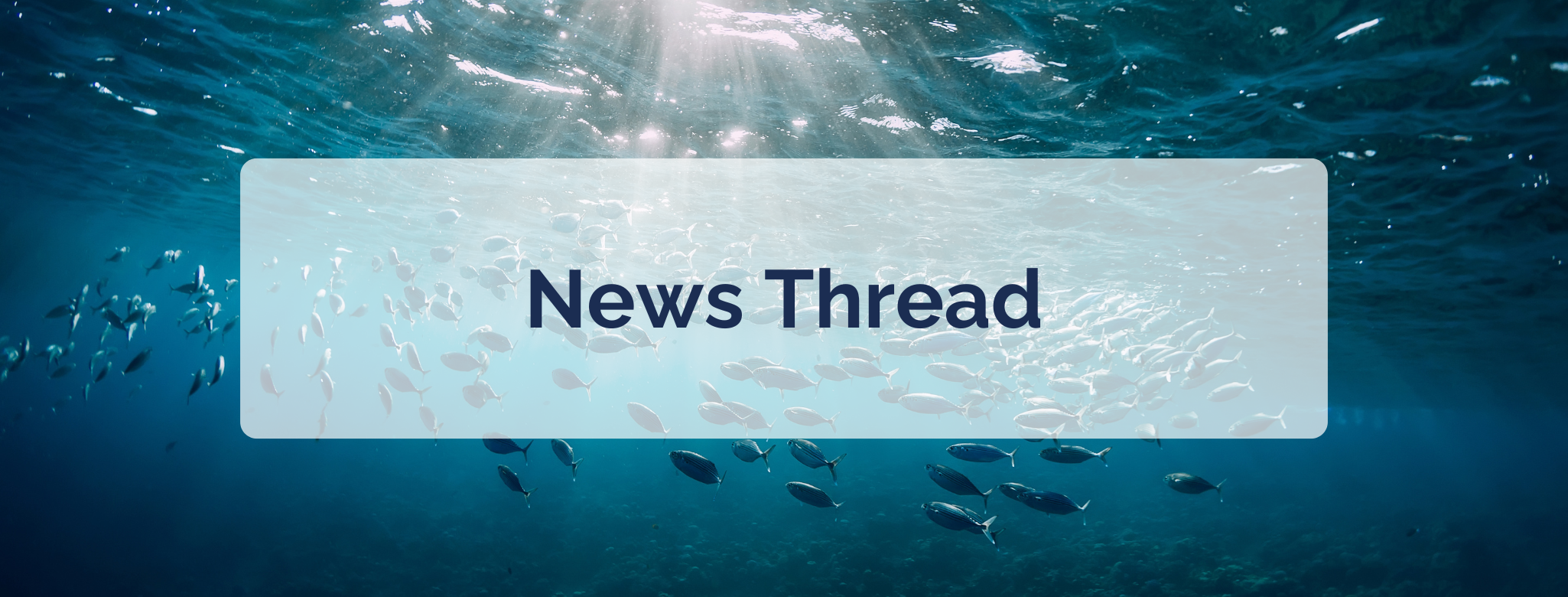
- President Biden expanded an executive order in December 2023 intending to prohibit the importation of “products harvested in Russian waters or by Russia-flagged vessels, even if these products are then transformed in a third country.” The Department of the Treasury has since confirmed this means a complete ban on imports of salmon, cod, pollock, and crab of Russian origin, no matter where these have been processed. The proclamation caused a stir in the industry, widening the rift between businesses that rely more on domestic and locally processed seafood versus imports and overseas processing. The National Fisheries Institute issued a statement warning that the EO expansion could result in supply chain confusion and disruption. Trident Seafoods, a domestic seafood leader and a champion of the ban, ended its NFI membership after the statement was issued.
- As the offshore wind 2024 outlook invites ever-expanding wordplay with the industry experiencing “headwinds and tailwinds”, we are watching wind power and its many players… unfurl in the current “wind change”.
- High tensions and a legal battle over Alaskan salmon continue to define the state’s favorite fish. Bottom line: who should manage and who should have access to salmon remains the question. The most recent litigation promises to pit Native against non-Native residents, rural residents against urban residents, and state managers against federal managers.
- Coastal storms in December and January wreaked havoc on Maine’s working waterfronts. In response, Maine lawmakers from coastal and inland communities have backed a bipartisan bill to support the small businesses facing devastation while Governor Mills has also sponsored separate legislation that would also implement state funds toward much-needed city and town infrastructure.
- The Maine Department of Marine Resources introduced aquaculture-friendly legislation that is currently being met with community opposition. This bill’s intent is to make processing aquaculture leases more efficient but the reduction in public notices and tighter requirements for a public hearing have caused many fishermen and community groups to boldly oppose.
- President Biden expanded an executive order in December 2023 intending to prohibit the importation of “products harvested in Russian waters or by Russia-flagged vessels, even if these products are then transformed in a third country.” The Department of the Treasury has since confirmed this means a complete ban on imports of salmon, cod, pollock, and crab of Russian origin, no matter where these have been processed. The proclamation caused a stir in the industry, widening the rift between businesses that rely more on domestic and locally processed seafood versus imports and overseas processing. The National Fisheries Institute issued a statement warning that the EO expansion could result in supply chain confusion and disruption. Trident Seafoods, a domestic seafood leader and a champion of the ban, ended its NFI membership after the statement was issued.
- As the offshore wind 2024 outlook invites ever-expanding wordplay with the industry experiencing “headwinds and tailwinds”, we are watching wind power and its many players… unfurl in the current “wind change”.
- High tensions and a legal battle over Alaskan salmon continue to define the state’s favorite fish. Bottom line: who should manage and who should have access to salmon remains the question. The most recent litigation promises to pit Native against non-Native residents, rural residents against urban residents, and state managers against federal managers.
- Coastal storms in December and January wreaked havoc on Maine’s working waterfronts. In response, Maine lawmakers from coastal and inland communities have backed a bipartisan bill to support the small businesses facing devastation while Governor Mills has also sponsored separate legislation that would also implement state funds toward much-needed city and town infrastructure.
- The Maine Department of Marine Resources introduced aquaculture-friendly legislation that is currently being met with community opposition. This bill’s intent is to make processing aquaculture leases more efficient but the reduction in public notices and tighter requirements for a public hearing have caused many fishermen and community groups to boldly oppose.
- President Biden expanded an executive order in December 2023 intending to prohibit the importation of “products harvested in Russian waters or by Russia-flagged vessels, even if these products are then transformed in a third country.” The Department of the Treasury has since confirmed this means a complete ban on imports of salmon, cod, pollock, and crab of Russian origin, no matter where these have been processed. The proclamation caused a stir in the industry, widening the rift between businesses that rely more on domestic and locally processed seafood versus imports and overseas processing. The National Fisheries Institute issued a statement warning that the EO expansion could result in supply chain confusion and disruption. Trident Seafoods, a domestic seafood leader and a champion of the ban, ended its NFI membership after the statement was issued.
- As the offshore wind 2024 outlook invites ever-expanding wordplay with the industry experiencing “headwinds and tailwinds”, we are watching wind power and its many players… unfurl in the current “wind change”.
- High tensions and a legal battle over Alaskan salmon continue to define the state’s favorite fish. Bottom line: who should manage and who should have access to salmon remains the question. The most recent litigation promises to pit Native against non-Native residents, rural residents against urban residents, and state managers against federal managers.
- Coastal storms in December and January wreaked havoc on Maine’s working waterfronts. In response, Maine lawmakers from coastal and inland communities have backed a bipartisan bill to support the small businesses facing devastation while Governor Mills has also sponsored separate legislation that would also implement state funds toward much-needed city and town infrastructure.
- The Maine Department of Marine Resources introduced aquaculture-friendly legislation that is currently being met with community opposition. This bill’s intent is to make processing aquaculture leases more efficient but the reduction in public notices and tighter requirements for a public hearing have caused many fishermen and community groups to boldly oppose.
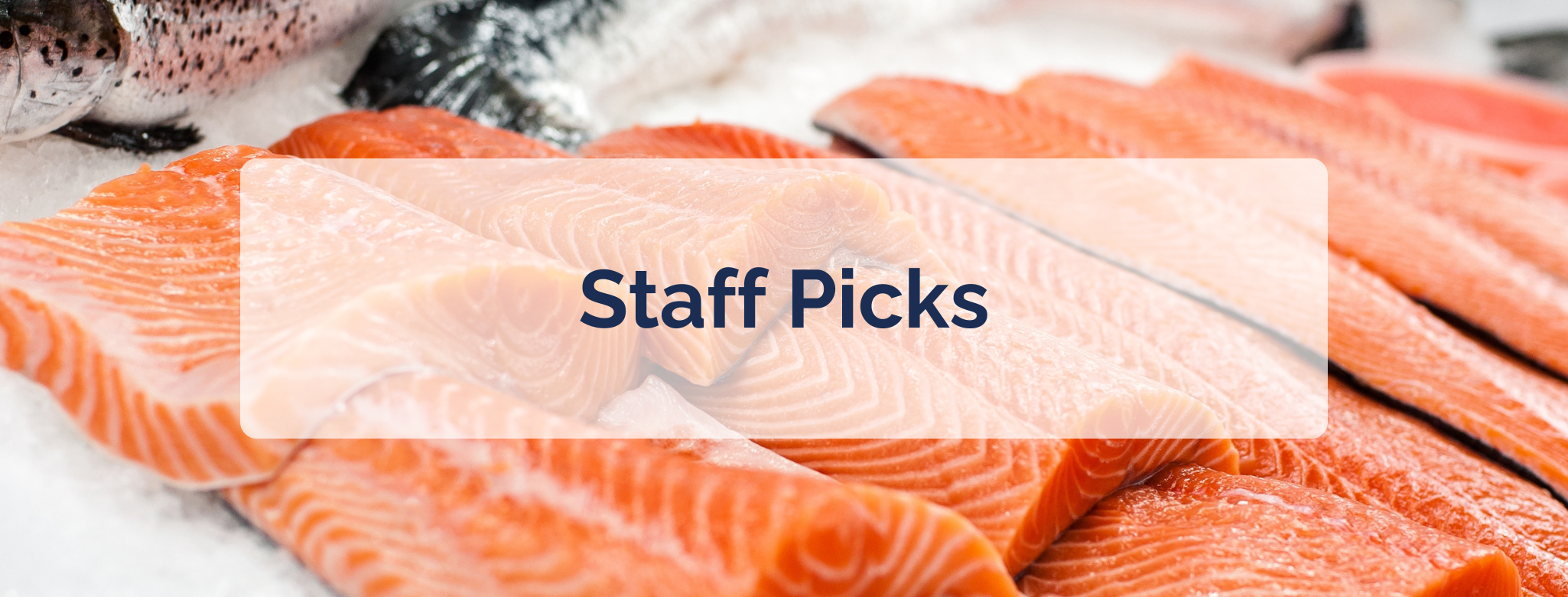
What We’re Reading, Watching & Listening To
With Ocean Strategies’ Principal Brett Veerhusen on the board of Fed by Blue’s groundbreaking, three-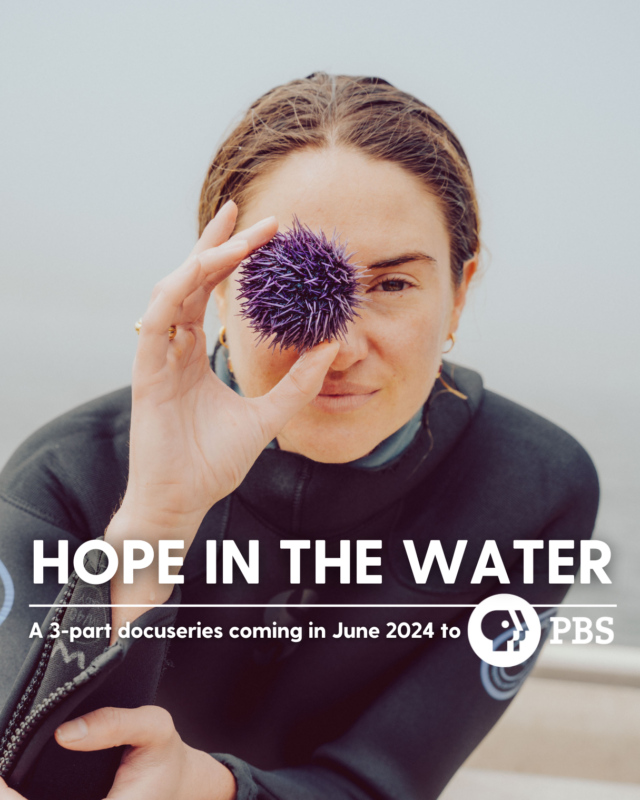 part docuseries Hope in the Water – it is no secret that we are looking forward to the PBS premiere in June. The series will showcase blue food solutions and technologies around the globe to help feed our world and save our waters. Celebrated environmentalists Shailene Woodley, Baratunde Thurston, Martha Stewart, and Chef Jose Andres will be meeting with and sharing the stories of amazing innovators, water farmers, and fishermen. Hope in the Water is produced by storytelling visionary and multi-award-winning producer David E. Kelley in collaboration with 4-time James Beard Award and Emmy Award winner Chef Andrew Zimmern and his production company In2itive Content.
part docuseries Hope in the Water – it is no secret that we are looking forward to the PBS premiere in June. The series will showcase blue food solutions and technologies around the globe to help feed our world and save our waters. Celebrated environmentalists Shailene Woodley, Baratunde Thurston, Martha Stewart, and Chef Jose Andres will be meeting with and sharing the stories of amazing innovators, water farmers, and fishermen. Hope in the Water is produced by storytelling visionary and multi-award-winning producer David E. Kelley in collaboration with 4-time James Beard Award and Emmy Award winner Chef Andrew Zimmern and his production company In2itive Content.
Seafood & Gender Equality (SAGE), led by the outstanding Julie Kuchepatov, has a March 2024 podcast/interview with Sarah Schumann from Fishery Friendly Climate Action where they discuss “everything from the multifaceted challenges of offshore wind development to solarizing the seafood industry”. The Conch podcast is already celebrating Season 5 so while you’re there, check out past installments!
An NPR interview and a cultural peek at one family’s perspective on the Yukon Salmon Fishery living in Gwichyaa Zhee, or Fort Yukon, about an hour’s plane ride from Fairbanks, Alaska. Gwichyaa Zhee is home to fewer than 500 mostly Gwich’in Athabascan people. Summers are strangely quiet as state and federal officials have banned all fishing.
Events & Opportunities
- April 11–13 – Comfish Alaska, Kodiak, Alaska
- April 23-25 – Seafood Expo Global, Barcelona, Spain
- April 23-26 – Kodiak Area Marine Science Symposium, Kodiak, Alaska
- May 21-22 – The Future of Florida’s Commercial Fisheries Summit, St. Augustine, FL
- September 11-12 – Seagriculture -3rd International Seaweed Conference USA, Ketchikan, Alaska
Here is a list of links to our most recent policy reports. You are always able to find them on our Ocean Pulse Blog. If you’d like to receive them directly, just sign up here.
